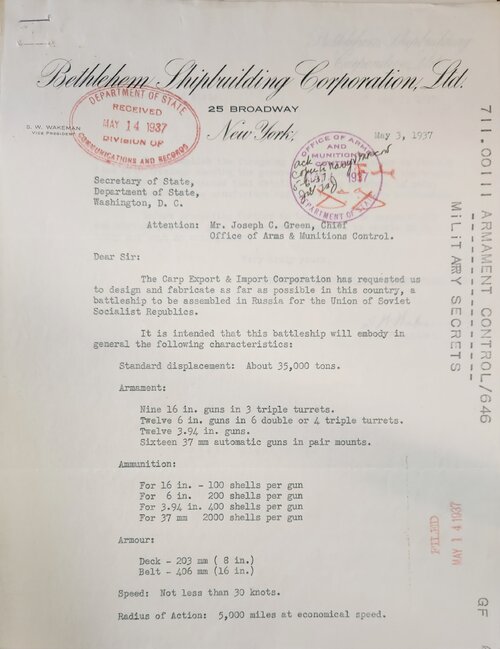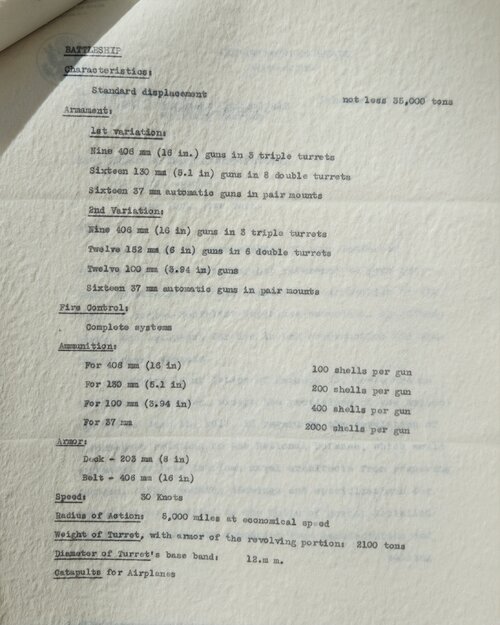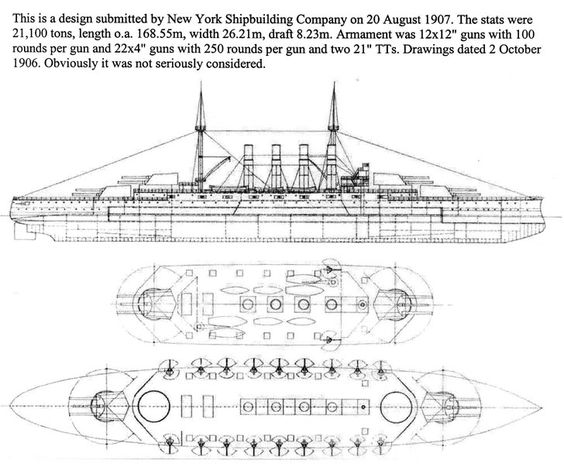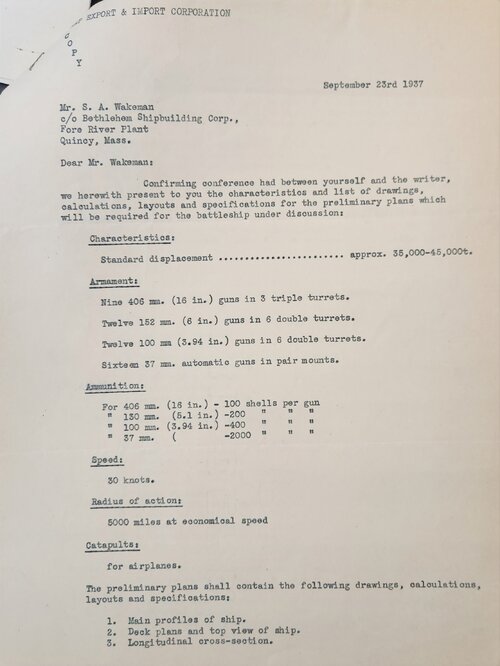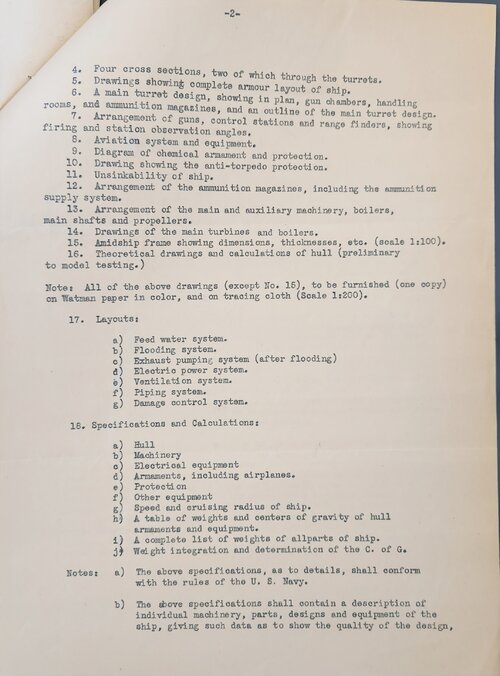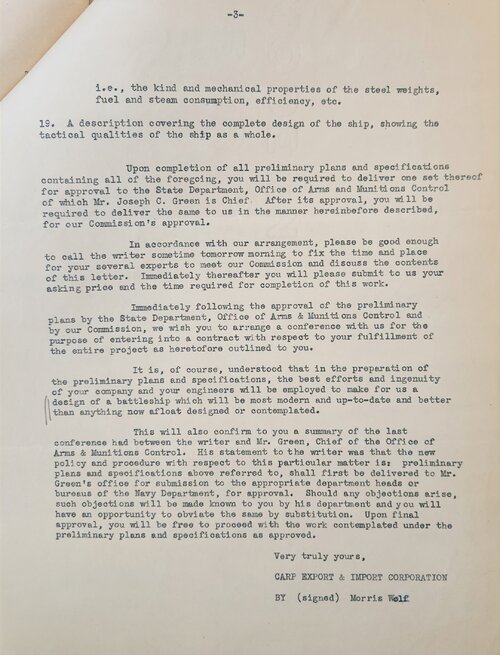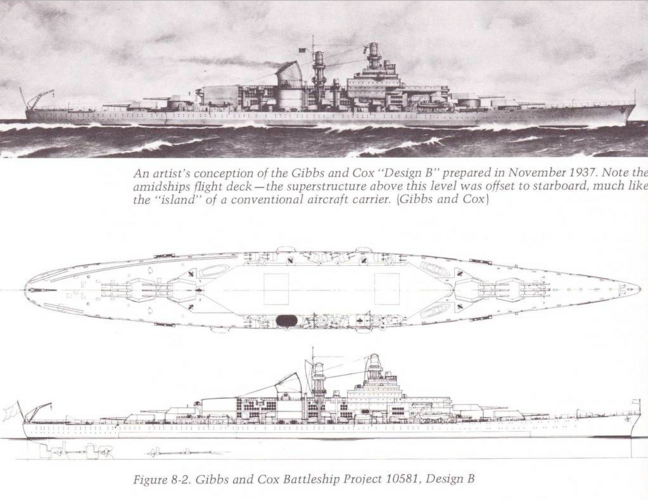Из «Суперлинкори Сталина» и «Флот, который уничтожил Хрущев»:
Концепции 1935-1936 годов:
Орудия 4х4х18", 26 узлов, лента 380 мм.
Орудия 3х3х20", 24-28 узлов, лента 500 мм.
Орудия 3х2х21", 24-28 узлов, лента 500 мм.
1945-1955 гг. Проект «Максимум» (огромный вариант пр.24):
Водоизмещение - 130 000 тонн.
Скорость до 29-30 узлов.
Основное орудие - 4x3x18" L/55: оболочка 1580-1720 кг, заряд 620 кг, начальная скорость 820-850 м/с, дальность 55+ км, 2-3 в/с.
Вторые варианты, или большого универсального калибра - 6х220 мм или 8х180 мм универсальных орудий (3х2, или 2х3 220 мм, 4х2 или 2х4 180 мм) - на базе башни проекта 84 - двуствольные 180-мм универсальные пушки, 9-10 встр/мин.
Универсальные пушки, или «малый» универсальный калибр – комбинация орудий 152+100 мм или только 130 мм. 152-мм просветы в трехместных башнях - до 16 встр/мин, 100 и 130-мм просветы в четырехместных башнях - до 18 встр/мин.
Данных о зенитных площадках "Максимума" у меня нет - на стандартном пр.24 они были 12х4х25 мм и 12х4х45 мм - и о броне - на стандартном пр.24 пояс 420-450 мм, палубы 245 мм.
...
И, Российские Имперские концепции (из «Последние Исполины Российского Императорского флота», С. Виноградов):
В 1914 году были поставлены два типа 16-дюймовых орудий L/45 со стандартным воздухом 1116,3 кг для «Викерс-Армстронг», заряд 320 кг, скорость 766 м/с и более мощная, для Обуховского завода, заряд 373 кг, скорость. 820-850 м/с. дальность 40+ км.
Также «в перспективе» в 1914 году на Обуховском заводе спроектировали мощную 18-дюймовую пушку L/45 — габарит 1586 кг, заряд 540 кг, начальная скорость 890 м/с, дальность 50+ км.
Инженер Изенбек спроектировал беспроводную систему зарядки для основных устройств и в проектах русских 16-дюймовых линкоров времен мировой войны, использовавших башни с этой системой. Система Изенбека: подача без промежуточных принципов, минимальное опускание ствола и др. - аналог советской танковой «карусельной» системы зарядки времен Холодной войны. Стандартная скорострельность, без дополнительного оборудования - 4 выстр/мин на стволе (!) калибра 16 дюймов, но "при необходимости и больше". Один российский проект 8х16" - это на самом деле два 8х16" королевского или британского линкора

)) В России проектируются 8, 9, 10, 12 и 16-пушечные 16" линкоры, это 35,7, 40,18, 44,65 , 53,58 и 71,44 тонны на минуты - Ямато (9 орудий х 1460 кг х 2 в/мин) - 26,28 тонны в минуту Полный аналог - Тиллман, 5х3х18" орудий, 1746 кг, 2 в/мин, 52,38 тонн в минуту.
Также спроектировались специальные телескопические системы управления для второго калибра с механизмом автозарядки. По этой концепции второй калибр был более легким, чем стандартный – малобронированным (только пушки и системы). Построенное орудие 6" L/50, окружающая среда 47,3 кг, скорость 850 м/с, и проектируемое орудие 6" L/52, окружающая среда 47,3 кг, 914 м/с. Также работали над 7-дюймовыми и 7,1-дюймовыми окнами, проект 183-мм пушки L/52 - Б-1, Б-1-К и Б-1-П представлял собой советскую реинкарнацию этого проекта.
Также предоставляется бронирование для большого линкора — высокий пояс по всему виду, 12 дюймов, 18 дюймов в центре, две 2,5-дюймовые палубы. Бронирование башни – до 20 дюймов.
А, проектируемый тип артиллерии, орудийные башни 2х4 и 2х2.
Также проектируется множество орудий – специальных зенитных или только автоматических.
На пуш-базе Максима проектировалась 47-мм автоматическая пушка. Также создан концепт 76,2- и 95-мм (!) пушек Максима.
Инженер Розенберг в 1901 году (!) спроектировал 57-мм 6-зарядную автоматическую зенитную пушку.
Братья Сергей и Василий Валицкие в 1885 году сделали 87-мм автоматическую пушку на базе полевой пушки образца 1877 года. Возможно, это был первый российский автоматический пистолет.
В 1915 году князем Чегодаевым была предложена 19-ствольная (Гатлинг?!) зенитная пушка «в минимальном артиллерийском калибре» - в Российской империи 37 мм.
Также в 1915 году инженер Краукле спроектировал газовый револьверный крупнокалиберный пулемет.

